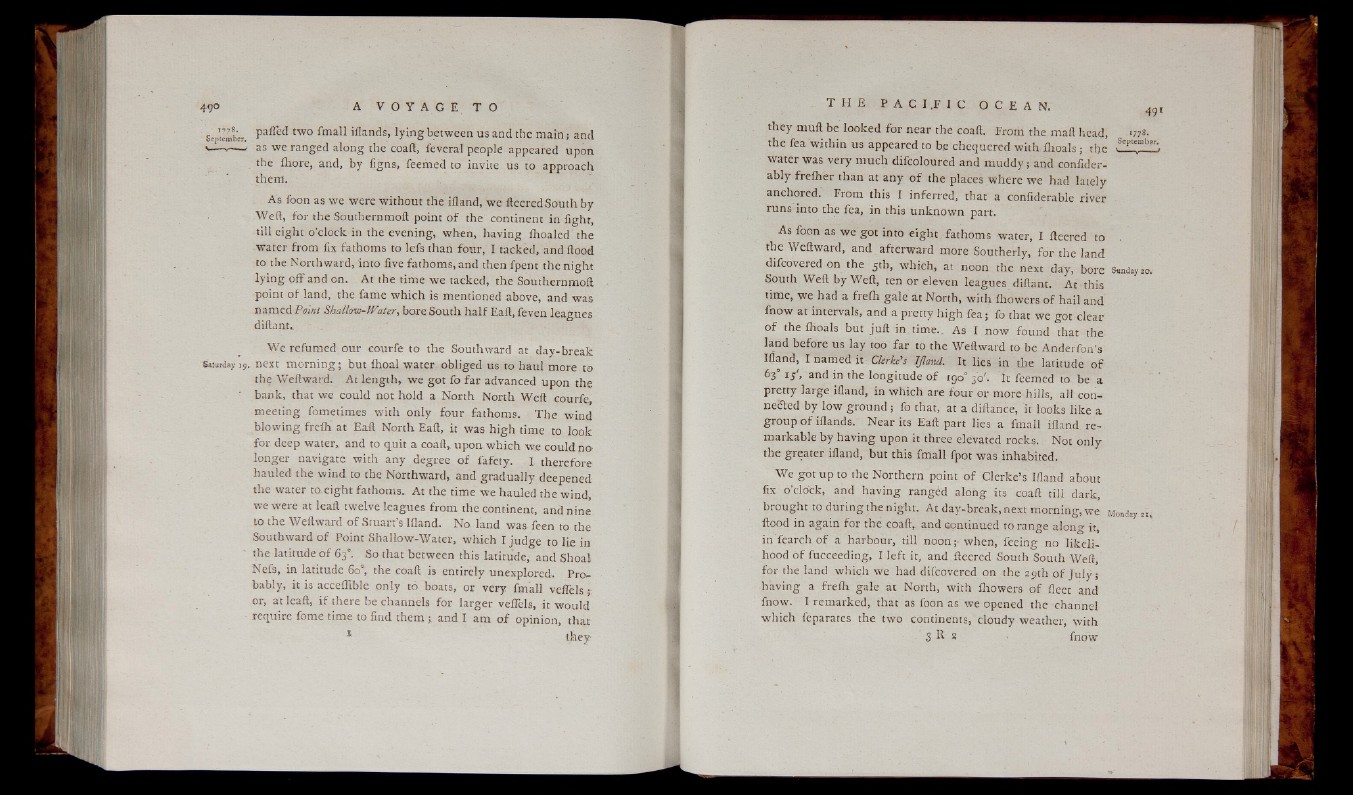
September. tw0 fma11 iflands, ly in g between us and the main j and
v,— i— - as we ranged along the coaft, feveral people appeared upon
the ihore, and, by figns, feemed to invite us to approach
them.
As foon as we were without the ifland, we fleered South by
Weft, for the Southernmoft point o f the continent in fight,
till eight o’clock in the evening, when, having fhoaled the
water from fix fathoms to lefs than four, I tacked, and flood
to the Northward, into five fathoms, and then fpent the night
ly in g o ff and on. At the time we tacked, the Southernmoft
point of land, the fame which is mentioned above, and was
named Point Shallom-IVaUr, bore South h a lf Eaft, feven leagues
diftant..
We refumed our courfe to the Southward at day-break
S a tu rd a y 1 9 . next m o rn in g ; but fhoal water obliged us to haul more to
the Weftward. At length, we got fo far advanced upon the
bank, that we could not hold a North North Weft courfe,
meeting fometimes with only four fathoms. T h e wind
blowin g frefh at Eaft North Eaft, it was high time to look
fo r deep water, and to quit a coaft, upon w hich we could n o
longer navigate with any degree o f fafety. I therefore
hauled the wind to the Northward, and grad ually deepened
the water to.eight fathoms. At the time we hauled the wind,
we were at leaft twelve leagues from the continent, and nine*
to the Weftward o f Stuart’s Ifland. No land was feen to the
Southward o f Point Shallow-Water, which I ju d g e to lie in
' the latitude o f 63'. So that between this latitude, and Shoal
Nefs, in latitude 6o°, the coaft is entirely unexplored. Pro.-
bably, it is acceflible only to boats, or very fmall veflels -
or, at leaft, i f there be channels for larger veflels, it would
require fome time to find them | and I am o f opinion, that
1 theythey
muft be looked for near the coaft. From the mail head, 177s.
the fea within us appeared to be chequered with iho a ls; the ,Sl!fte_mber-.
water was very much difcoloured and m u d d y ; and confider-
ably fre iher than at any o f the places where we had lately
anchored. From this I inferred, that a confiderable river
runs into the fea, in this unknown part.
As foon as we got into eight, fathoms water, I fleered to
the Weftward, and afterward more Southerly, for the land
difcovered on the 5th, which, at noon the next day, bore S u n d a y 20 .
South Weft b y Weft, ten or eleven leagues diftant. At this
time, we had a fre lh gale at North, with ihowers o f hail and
fnow at intervals, and a pretty high fea; fo that we got clear
o f the Ihoals but juft in time.. As I now found that the
land before us la y too far to the Weftward to be Anderfon’s
Ifland, I named it Clerke's IJland. It lies in the latitude o f
63 j§| > and in the longitude o f 190° 30'. It feemed to be a
pretty large ifland, in which are four or more hills, all connected
by low g ro u n d ; fo that, at a diftance, it looks like a
group o f iflands. Near its Eaft part lies a fmall ifland remarkable
by having upon it three elevated rocks. Not only
the greater ifland, but this fmall fpot was inhabited.
We got up to the Northern point o f Clerke’ s Ifland about
fix o’clock, and having ranged along its coaft till dark,
brought to during the night. At day-break, next morning, we Monday 2i,
flood in again for the coaft, and continued to range a long it,
in fearch o f a harbour, till noon ;-when , feeing no lik e lihood
o f fucceeding, I left it, and fleered South South Weft,
for the land w hich we had difcovered on the 29th o f J u ly ;
having a fre ih gale at North, with ihowers o f fleet and
fnow. I remarked, that as foon as we opened the channel
which feparates the two continents, cloudy weather, with
3 TI s fnow